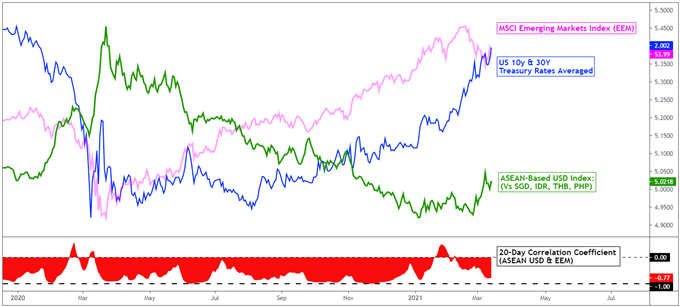US Dollar, Singapore Dollar, Thai Baht, Indonesian Rupiah, Indian Rupee, ASEAN, Fundamental Analysis – Talking Points
- US Dollar rose vs. most ASEAN FX as Treasury rates climbed
- All eyes on the Federal Reserve for their view on bond market
- USD/IDR eyeing Bank of Indonesia, more intervention ahead?
Discover what kind of forex trader you are
US Dollar ASEAN Weekly Recap
The haven-linked US Dollar outperformed most of its ASEAN counterparts last week, gaining against the Singapore Dollar, Indonesian Rupiah and Thai Baht – as expected. Longer-term Treasury yields continued climbing, with the 10-year rate closing at its highest since the middle of February 2020. Meanwhile, the MSCI Emerging Markets Index (EEM) consolidated, finishing just 0.3% to the upside.
A notable exception in the ASEAN space last week was the Philippine Peso, which gained slightly against the US Dollar. The local 10-year government bond yield at one point soared to 4.28%, hitting its highest since June, helping PHP to capitalize on rising rates of return on Philippine debt. This is despite intensifying capital outflows, which saw global funds sell the most Philippine equities in roughly 5 years, according to Bloomberg.
US Dollar, MSCI Emerging Markets Index – Last Week’s Performance

*ASEAN-Based US Dollar Index averages USD/SGD, USD/IDR, USD/THB and USD/PHP
External Event Risk – Fed, BoE, BoJ
Rising longer-term Treasury yields continue to be a key threat for SGD, PHP, IDR and THB. These can reduce investment capital from riskier markets, such as those in ASEAN and Emerging Markets, as forgoing bonds becomes increasingly more expensive. Should this induce market volatility, the anti-risk US Dollar could stand to benefit on top of portfolio reallocations.
With that in mind, arguably the most important event risk for ASEAN currencies will be the Federal Reserve monetary policy announcement on Wednesday. Traders will be tuning in to see what the central bank thinks of rising Treasury yields and whether or not action could be warranted. This past week, the ECB stepped up bond purchases to avoid unnecessary policy tightening.
Commentary from Fed Chair Jerome Powell earlier in March seemed to hint that the central bank was relatively sanguine about developments in bond markets. Combine this with the passage of the US$ 1.9 trillion Covid-relief bill, as well as with an anticipated subsequent infrastructure spending package, it is unsurprising to see Treasury rates continue climbing. This is as the US may aim to start vaccinating all adults in early May.
Similar soft language from the Fed could open the door to further progress in bond yields, pushing the US Dollar higher against its ASEAN counterparts. It should be noted that the Bank of England and Bank of Japan will also have their latest interest rate announcements ahead. They may also take the opportunity to calm markets about rising bond yields, perhaps inspiring


Recommended by Daniel Dubrovsky
How can you overcome common pitfalls in FX trading?
ASEAN, South Asia Event Risk – Bank of Indonesia
Focusing on the ASEAN economic docket, a notable economic event risk will be the Bank of Indonesia monetary policy announcement on Thursday. While the benchmark 7-day reverse repo rate is expected to remain unchanged at 3.5%, the central bank may step up rhetoric and action to keep the Rupiah from depreciating significantly. It already did this last week as it sees its currency as undervalued. As such, upside USD/IDR pressure could be restrained should Treasury yields keep rising. Meanwhile, Singapore will release non-oil exports and the Philippines will update on overseas remittances for January.
Check out the DailyFX Economic Calendar for ASEAN and global data updates!
On March 12th, the 20-day rolling correlation coefficient between my ASEAN-based US Dollar index and the MSCI Emerging Markets index changed to -0.77 from -0.71 one week ago. Values closer to –1 indicate an increasingly inverse relationship, though it is important to recognize that correlation does not imply causation.
ASEAN-Based USD Index Versus EEM and Treasury Yields – Daily Chart
Chart Created Using TradingView
*ASEAN-Based US Dollar Index averages USD/SGD, USD/IDR, USD/THB and USD/PHP
— Written by Daniel Dubrovsky, Strategist for DailyFX.com
To contact Daniel, use the comments section below or @ddubrovskyFX on Twitter
|
|




Leave a Reply
You must be logged in to post a comment.